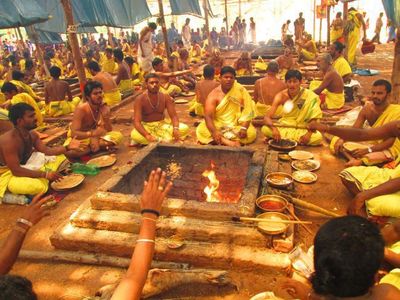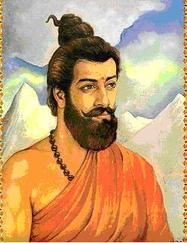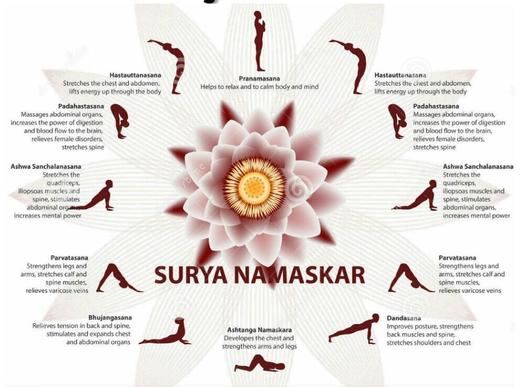|
Purva or Karma Mimansa Darshan (Chapters 12, verses 2731) is biggest darshan and was founded by Rishi Jamini in 4th century BC. Karma Mimansa has several sub-schools viz. Prabhakara sub-school & Bhatta sub-school (of 7th century BC). Karma Mimansa refers to examination of Vedic texts and stressed on Karmakanda (rituals) based on Vedas. It held that Vedas are eternal, authorless, and dharma means rituals & social duties. Ethics for this life and efficacious action for heaven (स्वर्ग) cannot be derived from sense-perception, and can only be derived from experience, reflection and understanding of past teachings. The ultimate aim of Karma Mimansa is achieving heaven. Deeds (कर्म) without aspiring for fruits and spiritual knowledge are means to get Heaven. By mastering the above two means, past deeds extinguish and man become liberated. Karma Mimansa has three parts viz. tools of knowledge (Perception, Inference, Analogy & Comparison, word, Postulation and non-perception), Spiritualism and Duty decider. Yajna (also called karma) are done for the achievement of a fruit like 'Heaven. Yajnas are performed on daily, fortnightly, monthly, annually and once in life time. Agnihotra is the homa done thrice a day. Yajna means worshipping, sacrifice & offering. The main constituents of Yajna are desire of doer (bhāvana), learning (svādhyāya), rites involved (karma), offerings i.e. Yaga-sacrifice, Dana-giving & Homa-offerings in fire (tyāga), devata and the results (phala). The ingredients used in a yajna are called dravya. Samskāra is a rite that involves mantra. There are forty samskāras or rites performed in one’s lifetime. The three parts of Karma Mimansa as under:
The main features of Karma Mimansa: continued........
0 Comments
Samkhya Darshan (451 Sutras and 527 including sub-verses, 6 chapters) was founded by Rishi Kapil around the 6th - 7th century BC. Samkhya Darshan, one of the six Hindu Philosophies deliberates on Prakriti, Jivatma and moksha. Samkhya means accurate, proper, and correct. Samkhya believes in dwatvad (द्वेतवाद) i.e. the creation is by Prakriti and Jivatma. The right knowledge (vivek) differentiates Prakriti (nature) and Jivatma (soul, prusha). Maherishi Kapil sometimes called as atheist. But many verses pronounce that Parmatma (Brahman, Supreme consciousness) is ultimate cause which proves him as theist. Samkhya Darshan has main principle of “Satkaryavad” (सत्कार्यवाद) means universe is created for some reason by original power. Satkaryavad has two forms viz. “Parinamvad” (परिणामवाद) and “Vivartvad” (विवर्तवाद). Parinamvad means actual modification happens into substance. Vivartvad means actual modification does not happen but only appears. As per Samkhya Darshan, following are the key principles:
Patanjali Yoga Darshan –The Practical steps to Bliss & Powers
Yoga Darshan (194 Sutras, 4 chapters) was founded by Rishi Patanjali between the 4th century BC - 2th century AD. Yoga Darshan, one of the six Hindu Philosophies is practical training to attain moksha. Yoga means joining or union. Yoga Shastra has four areas viz. universe, reason of creation of universe, liberation (moksha) and means of attaining liberation. These four areas are deeply investigated as under:
To get rid of miseries and to attain Kaivalya, eight limbs or parts of yoga are prescribed by rishi Patanjali. The Practice of eight limbs of Yoga leads to destruction of impurity which ultimately leads to light of self-awareness. In the light of self-awareness, Jivatma appears different from mind, buddhi, ego and senses. The eight parts (of the self-discipline of Yoga) are Yama (Self-restraints, यम), Niyama (observances of rules, नियम), Asana (posture, आसन), Pranayama (regulation of breath, प्राणायाम), Pratyhara (abstraction, प्रत्याहार), Dharna (concentration, धारणा), Dhyana (meditation, ध्यान), Samadhi (trance, समाधि). (यमनियमासनप्राणायामप्रत्याहारधारणाध्यानसमाधयोऽष्टावअङ्गानि 2/29). Yama, Niyama, Asana, Pranayama and Pratyhara are external limbs and Dharna, Dhyana & Samadhi are internal limb. Dharna, Dhyana & Samadhi is external limb of Asamprajaatah Samadhi (seedless Samadhi). The details are as under:
The detailed explanations, chapter wise and verse-wise are as under: |
Archives
July 2024
Categories |




 RSS Feed
RSS Feed